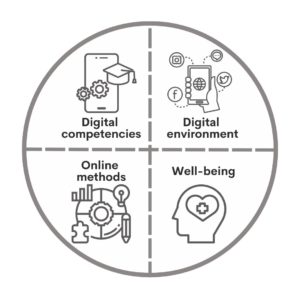 How do we establish spaces that will enable young people to build community and feel a sense of belonging? In the project partnership, we found an answer to the question in planning the user experience through four dimensions: online environment, work methods, (digital) competencies of youth workers and young people, and concern for well-being. Let’s briefly review the meaning of each dimension.
How do we establish spaces that will enable young people to build community and feel a sense of belonging? In the project partnership, we found an answer to the question in planning the user experience through four dimensions: online environment, work methods, (digital) competencies of youth workers and young people, and concern for well-being. Let’s briefly review the meaning of each dimension.
The first dimension is the digital environment. Let’s choose one that will enable the type of activity we are planning. The digital environment consists of a platform where we meet and tools that can support the process. The choice of digital environment defines how diverse the activities we can host in it will be.
Another dimension is digital competencies. These impact the quality of the process and space design, enabling participation and the well-being of those involved. To face a new reality, we were forced to rapidly upgrade our digital skills and knowledge in 2020, while the third part of competence – attitude – remained undernourished. Many youth workers do not believe that using the Internet brings added value and that the developed practices will be worth keeping even when the pandemic is just a bad memory. This attitude is why our activities often lack the motivation to go from a culture of online events to integrated youth work.
The third dimension is online methods. Youth work and its methodology have been developing for over a hundred years, but we were (mostly) confronted with the fact that it would be good to establish a repertoire of online methods as late as 2020. In the beginning, we introduced the dynamics of meetings by working in groups and using digital tools, which we equated with a method. In the coming years, the sector’s task is to step forward in developing and implementing methods that will support a similar feeling as when we meet in person.
the fact that it would be good to establish a repertoire of online methods as late as 2020. In the beginning, we introduced the dynamics of meetings by working in groups and using digital tools, which we equated with a method. In the coming years, the sector’s task is to step forward in developing and implementing methods that will support a similar feeling as when we meet in person.
As the fourth dimension, we have identified concern for well-being. Involving young people who want to participate actively is essential because creating a homely feeling and a safer space in activities with low participation is challenging. It is necessary to devote some time to develop a mutual agreement and focus on establishing connection between people before the content. We need to create informal socializing and entertainment opportunities that work as a link between participants. In addition, for longer cooperation, it is crucial not to forget the need for meaningful participation, which motivates the participants even in the long term.
By paying attention to all four dimensions described above, we can create a space for an inspiring experience that is connecting, fun, and encouraging, which boosts creativity and initiative, and has a place in youth work.
Author: Sabina Belc in Matej Cepin
Images: DALL-E from Open AI
Infographic: Eva Gajšek
